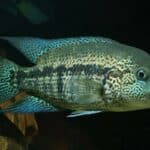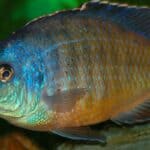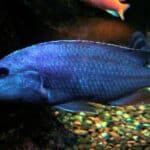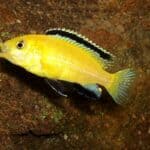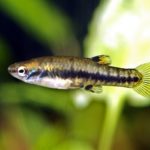The Mayan cichlid (also known as the Mexican mojarra or scientifically known as the Mayaheros urophthalmus) is a species of cichlid native to Central America.
Its distribution has since spread throughout South Florida and Mexico all the way down to Nicaragua. Due to its wide distribution, the Mayan cichlid has a conservation status of Least Concern.
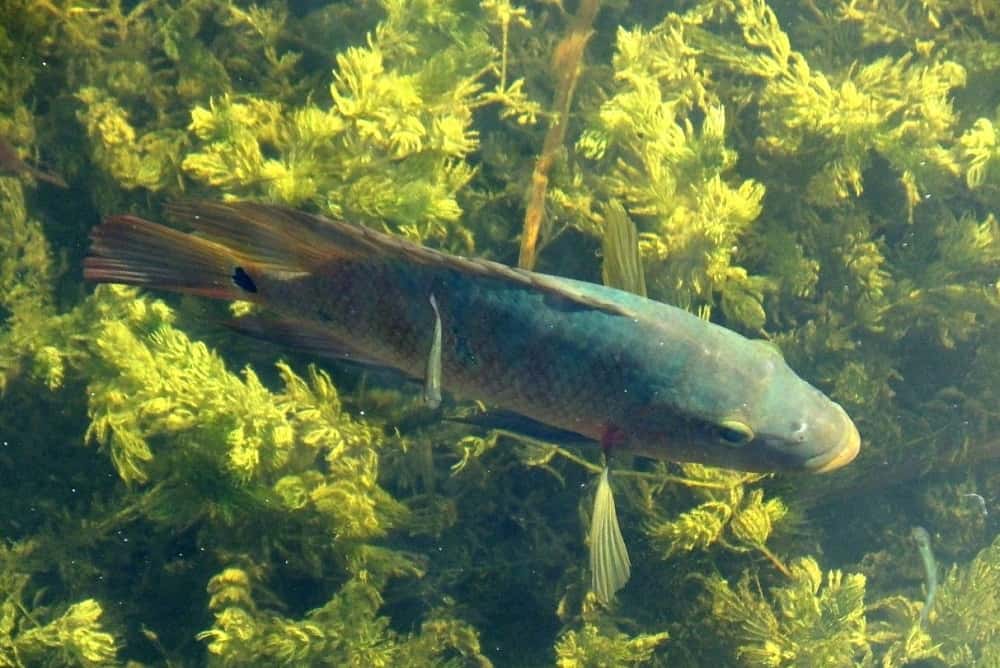
Anglers in the Mayan cichlid’s native region have a love-hate relationship with the species. While the species is in abundance and offers a lot of flesh for aquaculture purposes, the Mayan cichlid is a notoriously annoying fish as it gets in the way of anglers catching larger fish. The Mayan cichlid, after all, is one of the feistiest species when it comes to bait.
Its spunky temperament and unique coloring makes the Mayan cichlid a suitable species for only advanced hobbyists.
Care Guide
Tank Size
The Mayan cichlid is considered one of the largest cichlids, which means they are only suitable for a large tank. The minimum size tank for a Mayan cichlid should be 45 gallons of water per fish, and this can go all the way up to (and over) 123 gallons.
Keeping them in a smaller tank should only be for isolation and quarantining purposes, as the Mayan cichlid likes to swim. Plus, this species can be feisty, so you don’t want to add to their temperament by putting them in a small tank.
Tank Mates
Finding suitable tank mates for the Mayan cichlid can be tricky due to the cichlid’s feisty temperament. This means that the only suitable tank mates need to be a similar size to the Mayan cichlid and have to share similar feeding habits, otherwise the cichlid will become aggressive and will either bully or eat its tank mates.
The most compatible tank mates for the Mayan cichlid are other cichlid species, such as the red devil cichlid, red-spotted cichlid, redhead cichlid, Midas cichlid, and the black belt cichlid. As these species aren’t too closely related to the Mayan cichlid, they shouldn’t be perceived as a threat.
Same Species Tanks
The Mayan cichlid is a notoriously territorial species. This means that any fish that is closely related to the species, or even of the same species, will not be welcomed by the Mayan cichlid.
This species will perceive anything related to it to be a threat, which will result in a lot of aggression in the tank. This is why it is not generally recommended having a same species tank of Mayan cichlids!
Water Parameters
The Mayan cichlid naturally lives in oxygen-rich freshwater habitats such as estuaries, rivers, lakes, marshes, mangroves, lagoons, and coastal islands.
Despite its love for oxygen-rich waters, this species can survive in extreme hypoxia conditions. They simply become less active to the point where they can survive virtual anoxia for a couple of hours.
Still, here are the ideal water parameters for a Mayan cichlid tank:
- Temperature: 75-79 °F
- Acidity: 7.5-8.5 pH
- Water hardness: 15-25 dGH
What To Put In Their Tank
The Mayan cichlid will spend most of its time in the mid-section and bottom of the tank. The mid-section is best for socializing with other species, while the bottom is their safe space for breeding purposes (wherein they are bottom dwellers).
This means that the ideal substrate for a Mayan cichlid is something soft like sand, as the gravel substrate can be harsh on the fish’s scales – not to mention how the cichlid might end up eating the gravel substrate.
While aquatic plants are good for most tanks to maintain the nitrogen levels, Mayan cichlids don’t get along well with real plants. This is because the high acidity level of the water for a Mayan cichlid doesn’t agree with the plants, not to mention how the species is likely to eat the plants. If you’re desperate to add greenery to the tank, perhaps opt for fake aquatic plants.
Instead, fill your tank with an abundance of rocks, pebbles, and caves! Mayan cichlids love to explore and hide away, plus they genuinely enjoy moving pebbles and rocks around to their liking. Just make sure that there are no sharp edges that could injure the fish, as this can lead to serious infections.
However, avoid using driftwood, as this will change the acidity of the water.
Common Diseases
It isn’t clear whether the Mayan cichlid is exposed to certain diseases due to its species or habitat. Here are some of the most common diseases to look out for in most cichlid species, especially if the tank is home to more than one species:
- Fish tuberculosis (mycobacterium)
- Malawi bloat
- Spironucleus parasites
- Fin rot
- Bacterial infections
Prevention is the cure when it comes to diseases in a tank. Ensure to maintain the water parameters strictly, as improper acidity levels is one of the main culprits to diseases among fish. Also, make sure to clean and renew the water frequently – we recommend changing 25% of the tank’s total water content weekly.
Food & Diet
The Mayan cichlid’s diet in the wild consists of small fish and invertebrates. This means that their carnivorous diet must be replicated in a protein-dominant diet in captivity. Commercial flakes and pellets are good for providing the fish with every nutrient possible, but they should only be used as a supplement.
You should feed your Mayan cichlids a mixture of:
- Slugs
- Snails
- Lobsters
- Crabs
- Shrimp
- Algae
It’s also common for Mayan cichlids to eat organic waste in the tank, which is always handy for cleaning!
The Mayan cichlid prefers small meals to large ones, so we recommend feeding this species two or three small meals a day – or alternatively, one large meal every other day.
Feeding them live fish, such as small fish or shrimp, is great for allowing them to exercise their natural feeding habits – though be cautious that this will encourage aggression.
Lifespan
In the wild, the average lifespan of a Mayan cichlid is 7 years, while the average lifespan of a Mayan cichlid in captivity is 11 years.
Appearance
The Mayan cichlid is considered one of the largest cichlid species, reaching up to 39.4 cm (15.5”) in length. When the species reaches adulthood, these fish are predominantly reddish in color with several green vertical stripes.
The reddish scales range in hues and pigmentations, as some will look more orange than red and vice versa.
The most distinguishing feature of the Mayan cichlid is the distinctive dark spot on its tail. It is believed that this spot is used to confuse prey into thinking the fish has a third eye, making it look more of a threat.
The dorsal and anal fin have soft sections designed to help the fish effortlessly swim through the Caribbean Sea. The caudal fin is rounded to provide more speed.
The Mayan cichlid also has a prominent protruding jaw.
Size
The Mayan cichlid is one of the largest cichlid species, reaching lengths of up to 15.5”. This is why they require a large tank.
Behavior & Temperament
The Mayan cichlid is a notoriously feisty species. Fishermen have a love-hate relationship with this species – despite the advantages of its abundance and wide distribution, the Mayan cichlid will almost always bite bait when anglers are trying to catch larger fish.
To other fish, the Mayan cichlid is equally feisty, but only when the other fish is related to the species. Anything smaller than a Mayan cichlid is also seen as easy prey. This species is only tolerant of fish the same size as them.
Breeding
The Mayan cichlid is a monogamous and aggressive breeder. This species is highly territorial and protective of their young, which is why breeding Mayan cichlids in a tank isn’t recommended. They will guard their fry for up to six weeks, and with their aggressive temperament, it’s not wise to allow them to mingle with other fish species.
Gender Differences: Male vs Female
The Mayan cichlid is said to be a sexually monomorphic species, meaning there are little physical differences to distinguish the males from the females. However, the key difference is that the male tends to be larger than the female, but they tend to grow far slower.
Fun Facts
- The Mayan cichlid is native to Central America, Honduras, Belize, Nicaragua, and Guatemala.
- In 1983, the first non-indigenous case of the species was found in South Florida, where the species now lives in abundance.
- Snowy egrets (a small white heron) are one of the predators to the Mayan cichlid next to larger fish and reptiles.
- The size of a Mayan cichlid is one of the reasons why the species is so popular in aquaculture – the amount of flesh the fish produces is popular in local cuisine. The other reason is because of its wide distribution and abundant population, meaning aquaculture isn’t a huge threat to the species.
- Due to the aggression levels and size of the Mayan cichlid, the species is only recommended being owned by advanced hobbyists who have a large enough tank to accommodate them.



